How to bleach linen and tulle in a washing machine at home
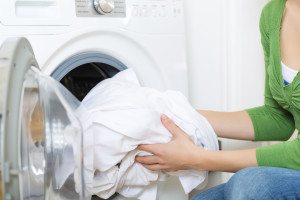 White tulle, linens, or other white items can become gray or yellow over time. Our grandmothers know excellent recipes on how to make bed linen snow-white, but to do this you will have to work with your hands and spend an hour of time. Therefore, the modern housewife has a question: how to bleach things in an automatic washing machine at home? Which product is best suited for this, and where should it be placed? Let's deal with everything in order.
White tulle, linens, or other white items can become gray or yellow over time. Our grandmothers know excellent recipes on how to make bed linen snow-white, but to do this you will have to work with your hands and spend an hour of time. Therefore, the modern housewife has a question: how to bleach things in an automatic washing machine at home? Which product is best suited for this, and where should it be placed? Let's deal with everything in order.
Whitening products
The household chemicals market offers a wide variety of whitening products. Depending on their composition and effect on fabric, bleaches can be divided into three groups:
- chlorine-containing – aggressive bleaches, produced mainly in liquid form. This product effectively copes with the task even when washed in water 400WITH.
Important! Chlorine-containing bleach, such as White, should not be poured into the washing machine.
- oxygen-containing – universal bleaches that are suitable for most types of
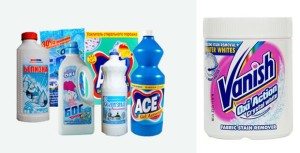 fabrics, including colored ones (Persol, Swan, Sail, Vanish, Velvet, Synergetic, Belle). They can be either liquid or dry. Most bleaches only work effectively at temperatures of 900WITH, but there are also those that can be used at a temperature of 400Yes, they cost more. Both are suitable for use in the washing machine.
fabrics, including colored ones (Persol, Swan, Sail, Vanish, Velvet, Synergetic, Belle). They can be either liquid or dry. Most bleaches only work effectively at temperatures of 900WITH, but there are also those that can be used at a temperature of 400Yes, they cost more. Both are suitable for use in the washing machine. - optical – brighteners. They contain luminescent dyes that create a whitening effect, but do not whiten. They are available for different types of fabrics (Bos Plus, Dr. Beckmann, Ace).
When choosing between dry and liquid bleach, base it on how often you'll use it. The fact is that Liquid bleaches have a short shelf life of 3-4 months, while dry bleaches can be stored for up to 5 years. In addition, you can select bleach depending on the type of fabric. There is bleach for tulle, underwear, silk items, and bleaches for cotton or linen.
Have whitening properties soda ash and salt, they can also be used for the washing machine. For example, to whiten tulle, you can add two tablespoons of table salt along with laundry detergent.
Bleaching in a washing machine: instructions
So, for effective bleaching in an automatic washing machine, you can use oxygen-containing bleach, which contains hydrogen peroxide. The bleaching process in a washing machine is much simpler than the manual method, but you must follow the instructions. This is the only way to achieve a positive effect.
Some modern washing machines have a separate compartment for bleach in the powder tray. Therefore, problems with bleaching should not arise. In this case, do this:
- Linen is placed in the drum, being sure to sort it by fabric type. This means that underwear is bleached separately from other fabrics, tulle, bedding, and towels are bleached separately. You can bleach cotton T-shirts and white socks together. Be careful, put only white things in the drum of the machine, one colored thing can ruin all the white ones.
- Then powder and bleach are poured into the cuvette into the appropriate compartments. The powder compartment is usually labeled II, and a triangle is drawn on the bleach compartment.
- Next, select a mode depending on the type of fabric. Tulle, white blouses, and silk items can only be washed on a delicate cycle. Bed linen, cotton T-shirts and socks, towels can be washed on the cotton cycle at temperatures from 60 to 900C, the washing temperature is indicated on the product label, so be sure to read the information.
Some washing machine models have a Whitening program. This means we choose it, but be sure to first read the instructions for the machine, and in particular everything about this program.
- We start the wash and wait for the result.
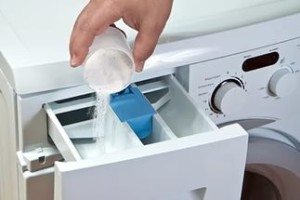
It seems simple, but what if your machine doesn’t have a special compartment for bleach, where to put it? In this case, it is necessary to carry out the bleaching process after the washing process. This is because the powder works effectively at 400C, and bleach at 60-900C. If the bleach is of high quality and is effective even in warm water, you can pre-wash and pour regular powder into compartment I, and pour dry bleach into the main compartment II. Select the washing mode depending on the fabric and start the process.
It is not recommended to add bleach to powders that contain enzymes. The effectiveness of the powder will be reduced.
Liquid bleach is convenient because it can be poured after the machine has filled with water and the powder has reacted. Just add a little water to the bleach and pour it into the main compartment, after which it will drain into the drum with the laundry.
Bleaching in a washing machine is convenient when you need to bleach bulky items such as tulle and bed linen. In addition, it is convenient to bleach in a washing machine at a temperature of 900C, there is no risk of getting burned.
Machine-free methods
It is not always possible to bleach clothes effectively in a washing machine. In this case, you have to use folk remedies for bleaching, as well as boiling and soaking. Manual bleaching is also appropriate when you only need to bleach a few small items, for example, underwear, a blouse, 2-3 towels. Here are some effective recipes on how to whiten things:
- bed linen effectively whitens. Whiteness is added to water at the rate of 3 tablespoons per 9 liters of water. The laundry is soaked in the resulting solution for half an hour and then rinsed well.
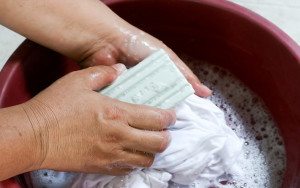
- You can bleach bed linen, towels and tulle using potassium permanganate, and things really become snow-white. To do this, you need to heavily soap things with laundry soap or use 250 g of powder per 10-12 liters of water. The water should be hot, 10 crystals of potassium permanganate are dissolved in it (the color of the water should be red) and the laundry should be poured in for 3 hours, then everything should be rinsed thoroughly.
- You can bleach items made from thin fabrics, such as blouses and shirts, using a solution of one spoon of 3% hydrogen peroxide, 1 tbsp. soda ash and 2 liters of water, the temperature of which is not more than 500C. Soak things in this solution for 2-3 hours, stirring them periodically.
- cotton items (T-shirts, socks, towels) can be bleached in hot water with the addition of boric acid;
- The boiling procedure helps to bleach cotton and linen items; to do this, place the laundry in an enamel tank, add powder and any bleach and boil for 20 minutes, stirring with a wooden stick. After boiling, you need to rinse the laundry with the addition of conditioner, it will help remove the unpleasant odor.
Some useful tips
The procedure for whitening white clothes at home is not always effective. It's all about following all the rules; there are a number of nuances that can affect not only the quality of bleaching, but in general can lead to the fact that the item will be completely damaged. So, here are some tips for bleaching your laundry.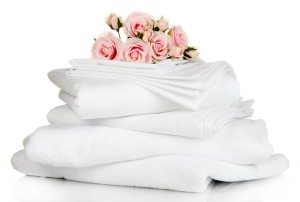
- Do not bleach a product with a rust stain, as this will only turn it yellow. First you need to remove the stain.
- Items with buttons, locks and other accessories are bleached only in water no more than 400C. In this case, soak for no more than 30 minutes.
- For manual bleaching, it is advisable to use plastic or enamel basins.
- Before bleaching in the washing machine, you need to check the pockets of things, and also shake out dust from the seams in the bed linen.
- When buying bleach, be sure to look at the release date and expiration date. The fresher the product, the higher the effectiveness.
- For effective bleaching, you can pre-soak the laundry in a basin and then wash it in the machine.
Thus, when bleaching towels, tulle and other things in the washing machine, pay special attention not only to the choice of a high-quality bleaching agent, but also to the temperature conditions. And most importantly, wash white items more often, and then you will have to bleach less often.
Interesting:
2 reader comments
Add a comment Cancel reply
Categories
Washing machine repair


For buyers

For users

Dishwasher


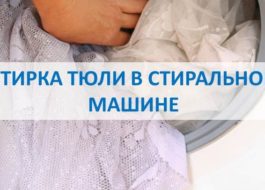
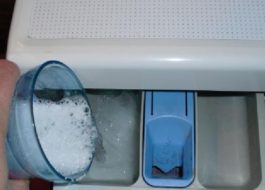
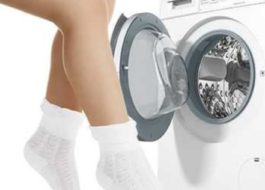

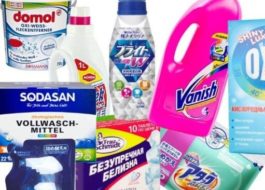










It’s not clear about potassium permanganate... Is this a joke? Potassium permanganate stains, not bleaches
When you add potassium permanganate to the water, then baby powder, the water turns white, not pink.